Akwaeke Emezi was born in 1987 in in Umuahia, Nigeria and studied at New York University. In 2017, they won the Commonwealth Short Story Prize for Africa. Emezi’s debut novel Freshwater was published one year later. Their latest novel The Death of Vivek Oji was published in 2020 in the U.S.
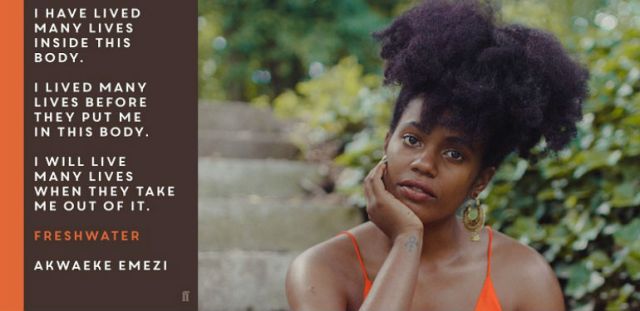
The New York-based author of Igbo Tamil descent, who also describes themselves as a „nonbinary trans and plural person“ explained in several interviews (e.g. Deutschlandfunk Kultur) that many elements of the novel are of autobiographical origin. Freshwater tells the story of a „plural individual“ – a transgender person called Ada whose body is inhabited by several personalities and occupied by various spirit beings from Igbo mythology.
The novel combines themes of gender, sexual violence, mental health, trauma, physicality and identity with elements of Igbo culture, specifically the Ogbanje. Ogbanje are evil spirits, the literal translation from the Igbo language is „children who come and go“. The Ogbanje picks a family and enters the body of one child to kill him or her before puberty. After the Ogbanje is done with that child, it returns to the same family to be reborn and the cycle repeats itself. Dr. Sunday Ilechukwu states in her article „Ogbanje/abiku and cultural conceptualizations of psychopathology in Nigeria“ that Ogbanjes choose predominantly female children. Furthermore she explains the suffering of Ogbanje children: „The most common psychiatric symptoms are visual hallucinations […], aggressive/destructive behavior […], conversion/dissociation disorders […], and vivid dreams about water […]The loss of control, unexplained symptoms (conversion), changes in conscious expression (dissociation), and dreams about water […] and play (with spiritual companions) suggest Ogbanje to the patients“. The aspect of water is, of course, particularly interesting in relation to the title of the novel.
In the Nigerian context, the phenomenon of Ogbanje is well known, Ogbanje is also used in speech as a synonym for stubborn children. Ogbanje are also a recurring literature motif from Nigeria and from the Nigerian Diaspora. One of the most known examples for this is the character Ezinma in Chinua Achebe’s Things Fall Apart.
Ada is one of those Ogbanje children. She is the daughter of a Nigerian doctor named Saul and his Malaysian wife, Saachi. From a young age, it is clear that Ada is different from the others which shows for example in self-injurious behavior. While most Ogbanjes die as children, Ada survives. But things get worse the older she gets. When Ada moves to the U.S. at 16 to go to college in Virginia, the Ogbanje’s voice grows stronger. Ada gets raped on her campus and the Ogbanje splits into many entities as a result. One entity named Asughara is especially powerful and dangerous. Asughara is a female spirit that wants to avenge Ada, but destroys her in doing so. There are times when Ada gives complete control over to that raging spirit. Asughara is a violent force, ruthlessly seeking sexual encounters, destroying Ada’s relationships in the process. She uses Ada’s body to seduce and to break men, but also to harm Ada. She cuts and hurts herself in many other ways, from unprotected casual sex, to excessive drinking and disordered eating. Ada tries to oppose Asughara, which almost ends in suicide, but she manages to get rid of her.
Ada goes through many relationships, some of them are intense or even traumatic, some are just fleeting and weak in meaning. However, Ada’s most intense relationships are not with other people, but with the voices inside her that contradict each other, take her over and tear her apart. Ada also carries a male entity within herself, this one is named Saint Vincent, which in contrast to Asughara is full of gentleness and makes her date women and explore her queer identity. She experiences gender dysphoria and tries to find ways to deal with it first by binding her chest and eventually by having surgery to reduce the size of her breasts.
Freshwater deals a lot with embodiments. Ada struggles with being in her body and with the trauma that is linked to this body, as well as with the entities living within her. Freshwater is about being trapped in a body, but the multiple personalities also enable a complexity and open up new perspectives.
By presenting the Ogbanje as reality in their novel, Emezi pays tribute to the elements of Igbo culture and develops the literary motives even further. With the colonization of Nigeria, much of the Igbo culture was lost, suppressed and discarded. With Freshwater, the author shows us a small insight into the multifaceted Igbo culture, but mixes this with modern twists. The novel blurs the lines between Igbo gods, mental illnesses and gender issues.
These themes are certainly not easy, but the narrative style that conveys them is outstandingly poetic and stylistically so powerful that it keeps the reader hooked. Freshwater is characterized by a thrilling narrative style, switching from the collective Ogbanje who refer to themselves as “We” to Ada herself, who barely narrates her own story, to the spirit Asughara. The alternating switching between characters and voices can first be irritating for the reader but it’s also one of the main points why the novel is so captivating.
After prize-longlisted Freshwater was praised by both critics and by the public on an international scale, Emezi is following up with a second novel called The Death of Vivek Oji. This new novel shares Freshwater’s themes, particularly in its exploration of ideas of selfhood, identity and embodiment, along with spirituality.
About the author:
Elena Schaetz is a student of African Studies (MA) at the Humboldt University of Berlin. Her research focuses on literature, culture, gender and queerness in South African regions.
von Elena Schaetz

copyright: Natalie Seery/HBO
Seit dem Erfolg ihrer Sitcom Chewing Gum (2015-2017) und spätestens nach ihren Rollen in den Netflix-Produktionen Black Earth Rising (2018) und Black Mirror (2017) wird die britisch-ghanaische Schauspielerin und Drehbuchautorin Michaela Coel als vielsprechende Künstlerin gefeiert. Ihre neuste Dramaserie, I May Destroy You, wurde im Juni 2020 erstmalig auf HBO und BBC One ausgestrahlt und wird bereits jetzt als eine der wichtigsten Produktion des Jahres betitelt. Grund dafür sind nicht nur die Themen, die die Serie verhandelt, sondern auch wie und aus welchen Perspektiven dies geschieht.
I May Destroy You ist die Geschichte von Arabella, einer jungen Londoner Autorin, welche in einer Partynacht K.O.-Tropfen untergemischt bekommt und anschließend bewusstlos Opfer einer Vergewaltigung wird. Am nächsten Morgen wacht sie mit einer Platzwunde und einer großen Erinnerungslücke auf und begibt sich zunehmend verzweifelt auf die Suche nach Hinweisen. Dabei geht es jedoch nicht nur um das Identifizieren des Täters, sondern auch um das Finden von Bewältigungs- und Verarbeitungsstragegien.
Entscheidener als der grobe Plot sind jedoch die kleinen Facetten der Serie, die verschiedene Perspektiven bieten: Da ist zum Beispiel Arabellas bester Freund Kwame (Paapa Essiedu), der ein Grindr-Date nach dem nächsten hat, bis auch er Opfer einer Vergewaltigung wird. Durch die Figur Kwames schafft es Coel, mehrere Tabu-Themen gleichzeitig aufzumachen – sensible black masculinity, black gayness und auch die in Medien selten gezeigte Seite von männlichen Opfern sexueller Gewalt.

copyright: HBO
Gerade Schwarze Männer werden in den meisten Film- und Fernsehproduktionen oftmals sehr hypermaskulin oder gar aggressiv gezeigt; sie sind Sportler, Dealer, Gangster oder Aufreißer. Das rassistische Klischee des hypersexuellen Schwarzen Mannes wird vielfach reproduziert. Coel hingehen zeigt eine andere Schwarze Männlichkeit, die auf Menschlichkeit beruht. Wir sehen Kwame als guten Freund Arabellas, der sich nach der traumatischen Erfahrung der Vergewaltigung erst zurückzieht und sogar seinen Freundinnen, die selbst Opfer sexueller Gewalt waren, zuerst nichts von seinem Problem erzählen kann.
Coel schafft ein realitätsnahes Bild; man sieht, wie schwer es gerade männlichen Opfern fällt, sich Hilfe zu suchen. Die sehr ernüchternde Erfahrung mit einem unsensiblen Polizisten, als Kwame die Vergewaltigung anzeigen möchte, zeigt auch, wie mit männlichen Opfern umgegangen wird und wie stigmatisiert schwuler Sex noch immer ist.
I May Destroy You verhandelt sexuelle Gewalt auf vielen Ebenen und zeigt dabei, dass die gleiche Straftat unterschiedlich thematisiert wird, je nach race und Gender der Opfer und Täter*innen.
Während Kwames Erfahrung auf der Polizeistation sehr negativ ist, wird mit Arabella als Frau viel sensibler umgegangen. Auch weitere Privilegien werden diskutiert. Etwa als eine Weiße ehemalige Schulkameradin von Arabella gezeigt wird, die eine Selbsthilfegruppe für Opfer sexueller Gewalt leitet, aber zur Schulzeit selbst einem Schwarzen Jungen eine Vergewaltigung unterstellt hat, nachdem dieser ein Sexvideo von ihnen geteilt hatte. Neben der Thematik, dass mit ihr als Weißer Frau anders umgegangen wird, wird hier eine weitere große Frage aufgemacht – wann beginnt Missbrauch?
Das fragt sich auch Arabella, die im weiteren Verlauf der Serie Opfer von Stealthing wird – dem heimlichen Abziehen des Kondoms ohne das Wissen oder die Zustimmung des Sexualpartners während des Geschlechtsverkehrs. Arabella erfährt zufällig beim Hören eines Podcasts, dass Stealthing unter britischen Gesetz eine Form der Vergewaltigung ist und konfrontiert den Täter mit dieser Beschuldigung.
Ihre beste Freundin Terry (Weruche Opia) hat im Italienurlaub einen Dreier, den sie als spontanes und selbstbestimmtes Abenteuer erlebt. Als sie später erfährt, dass die zwei Männer alles vermutlich geplant hatten, fühlt es sich nicht mehr so selbstbestimmt an. Man beginnt sich als Zuschauer*in selbst zu fragen – wo beginnen Übergriffe? Kann der Sex, den Terry mit den Männern hatte, dann überhaupt noch einvernehmlich gewesen sein?
Die Drama-Serie hat jedoch trotz der düsteren Themen auch leichte Momente. Sie zeigt Empowerment, Diversität, Freundschaften und alltägliche Probleme von Millennials, inklusive einer ausufernder Online-Selbstinszenierung, was der Serie noch mehr Authentizität verleiht. Wir sehen, wie Arabella ihre Arbeit aufschiebt, wenn sie pleite ist, Probleme mit der Deadline für ihren Buchdeal hat und wie sie mit Schreibblockaden kämpft.
Mit einem sehr diversen Cast rückt Coel die westafrikanische Diaspora Großbritanniens in den Vordergrund. Durch viele kulturelle Details gelingt eine authentische Darstellung, so etwa durch die Sprache – von Black British Slang, verschiedenen westafrikanischen Akzenten, Twi, das in Arabellas Familie gesprochen wird, bis hin zu Yoruba-Wortfetzen („Oya!“ – „come on!“).
Obwohl auch Weiße Frauen sich mit vielen Themen aus I May Destroy You identifizieren können, bleibt es die komplexe Geschichte einer Schwarzen Frau, was angesichts der Unterrepräsentation Schwarzer Frauen in Medien von großer Bedeutung ist. Wärend viele Serien sich rassistischer Klischees der „Black Mama“, „angry black woman“ etc. bedienen, gelingt Coel eine vielschichtige und überzeugende Darstellung Schwarzer Identitäten. Rassismus wird zwar auch thematisiert, die Schwarzen Protagonist*innen werden jedoch nicht darauf reduziert.
Trotz all des Lobs bedarf es auch kritischer Anmerkungen. Eine Szene ist mir hier deutlich in Erinnerung geblieben: Kwame beschließt nach der erlebten Vergewaltigung, erst einmal Abstand von Männern zu nehmen und schläft mit einer Weißen Frau, welche Schwarze Männer fetischisiert. Als sie nach dem Sex etwas Homophobes äußert, erzählt Kwame, er sei selber schwul, worauf sie ihn wütend auf der Wohnung wirft, sie fühle sich missbraucht von ihm. Kwame ist zuerst verunsichert, dann sichtlich beschämt. Ein Gespräch mit seinen Freundinnen verschlimmert dies noch. Hier gehen die Stimmen der Zuschauerschaft auseinander, hat Kwame die Frau im falschen Glauben gelassen, er wäre heterosexuell, um mit ihr zu schlafen? Sind sie etwa „quitt“, weil er nichts von seiner Queerness erzählte, sie ihn aber auch sichtlich fetischisierte? Ich persönlich konnte die Szene nicht nachvollziehen; warum spielt es eine Rolle, ob sich Kwame als schwul, bi-, pan-, oder heterosexuell versteht, wenn das Paar einvernehmlichen Sex hat? Ich hätte mir hier einen weiteren Blickwinkel gewünscht; der Schock der heterosexuellen Frau, als der eigene Sexpartner sich als queer herausstellt, ist zudem eine gängige homophobe Reaktion. Hätten sie ein anderes Datingverhalten gehabt, bei dem ein ehrliches (romantisches) Interesse von der Frau erkennbar gewesen wäre, dann wäre Kwames Verschweigen seiner eigentlichen Sexualität natürlich von anderem Gewicht. Dennoch, Sexualität ist ein Spektrum und Tendezen können sich auch ändern.
Nichtsdestotrotz ist I May Destroy You eine große Bereicherung der Popkultur, welche zurecht international gefeiert wird. Die diversen Perspektiven, aus welchen die Serien das Thema consent beleuchtet, hat es so in einer TV-Produktion noch nicht gegeben. Der Erfolg von I May Destroy You ist hier sicher auch wichtig, um den Weg für weitere feministische und antirassistische Produktionen zu ebnen.
Über die Autorin:
Elena Schaetz ist Studentin der Afrikawissenschaften (MA) an der Humboldt-Universität zu Berlin. Ihre Arbeitsschwerpunkte sind Literatur, Kultur, Gender und Queerness in südafrikanischen Regionen.
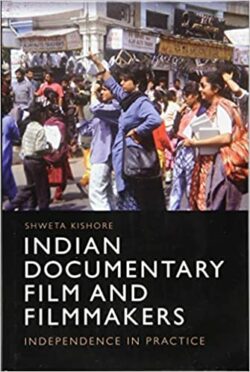
Reviewed by: Nadja-Christina Schneider
Reviewed item:
Shweta Kishore. 2018.
Indian Documentary Film and Filmmakers. Independence in Practice
Edinburgh: Edinburgh University Press
ISBN 9781474433068
The struggles of independent critical filmmakers in India: History going in circles?
In the summer of 2019, when the central government in India denied permission for ‘veteran’ documentary filmmaker Anand Patwardhan’s latest film Vivek (Reason) (2018) to be screened at the renowned International Documentary and Short Film Festival of Kerala, the organizers of the festival, together with Patwardhan, did what he often did when his earlier films faced state censorship. They took the battle to court, won the case, and finally got permission to screen the self-funded and searingly critical documentary at the festival in Thiruvananthapuram. Structured in eight parts, Vivek scrutinizes the mainstreaming of violent Hindutva ideology and majoritarian nationalism in India during the last decade. While the successful litigation in Kerala could be seen as a glimmer of hope for the continued possibility for audiences to engage with critical independent documentaries in India, the fact that Vivek, along with a number of other critically acclaimed films, was not screened at the 16th Mumbai International Film Festival in January this year (MIFF 2020) may not have come as a surprise for many.
Read the full article here: https://www.iias.asia/the-newsletter/article/indian-documentary-film-and-filmmakers
by Jingjing Feng, Pamela Gutierrez and Zuzanna Tarka
As a third project in the research-oriented MA course „Multi-local families in times of increased geographical and communicative mobility“ (summer term 2020), we present Jingjing Feng’s, Pamela Gutierrez’s and Zuzanna Tarka’s visual essay Comparative analysis of 3 documentaries reflecting on multi-local practices in 3 different cultures.
As people across the world people continue to migrate regionally and transnationally, more families find themselves searching for ways to “do family” from a distance. The benefits of migration are plentiful and for many include better financial opportunities and increased safety but often come at a steep cost (Kaur and Shruti, 2016; Faist, 2010). Multi-local families face daily logistical and emotional challenges that transcend nationality and culture despite the unique circumstances across the globe (Schrier, 2016). We chose to explore these cross-cultural challenges by analysing three short documentaries focusing on the countries and regions we identify with—Poland, China, and Latin America/ USA. We looked at “Violetta: Portrait of a Polish Immigrant in London”, “Year of the Dog: Inside the World’s Largest Human Migration,” which focuses on a couple migrating from a village in rural China into the city, and “Immigrant Voices of America: Esther Alvarado,” which explores a Mexican woman’s story of migration into the United States. Each offered us a unique perspective into the lives of multi-local families and how they rose to the challenge of “doing family” in circumstances that are quickly becoming more common throughout the world.
- Violetta – Portrait of a Polish Immigrant in London (2012)

Still from the documentary film “Violetta – Portrait of a Polish Immigrant in London” by Rabikowska, M. & Hawkins, M. (2012).
In this documentary we are shown the life of a Polish women in her mid-forties, an immigrant, who left the country for economic reasons. She has debts to repay back home and knows she can make a better living in the UK. In deciding to do that, her family needs to split – her daughter stays with her ex-husband, while her grown-up son goes with her to the UK to work. Despite having her son and some semblance of family in her new country of residence, the struggles of a multi-local family persist. When she talks about her daughter back home, she says “I miss Natalia terribly, despite everything. She is a girl, and it is different with a boy”. At home she says the two had a good relationship and could talk about anything, but that closeness is difficult to maintain from afar.
The familial dynamic with her son and partner also changed when they moved to London as they traded their family home for a shared, workers household. In the house, several multi-generational families live together under one roof and share common areas, as well as spend their free time together. The importance of family ties evolves for Violetta as she embraces her new community. Eventually they even act as a sort of substitute for her nuclear family as they live together, work together, and even go to church together. As this relationship with her housemates grows, their lives in London and Poland begin to overlap.

Still from the documentary film “Violetta – Portrait of a Polish Immigrant in London” by Rabikowska, M. & Hawkins, M. (2012).
On Easter she is seen celebrating with her housemates, phoning home together, and even switching phones to send regards to the other’s family members. Digital media and mobile devices play an important role in their multi-local family practices (Robertson et al., 2016; Schroeder, Ling, 2013). Occasionally, she and her friends and families visit each other back and forth between London and Poland. They all pay a lot of attention to keeping up the traditions, staying in touch with the loved ones who stayed at home and talk about their longing to go back to their country.
Her relationship with the UK is more complex and she experiences both gratitude and acceptance but sometimes also disappointment with life outside of Poland and without her family.
“It is not my second homeland, and I will never call it my homeland” says Violetta, despite living in London for years. Her immigration to London changes her sense of belonging back home in Poland but she doesn’t feel a sense of English identity either. It is touching when she says “After all, human beings are social creatures, and need someone else at all times, to love and to look after… Whether it is children, a husband, or parents, there’s always someone”. This sentiment also reflects in her frequent communication with friends and family back home and her continued longing to be with her daughter again.
2. Year of The Dog: Inside The World’s Largest Human Migration (2017)
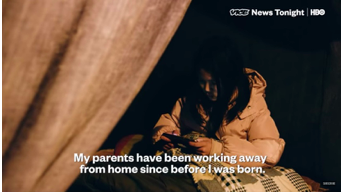
Still from the documentary film “Year of The Dog: Inside The World’s Largest Human Migration” by Vice (2017).
In this documentary we are introduced to a couple, Yang and his wife Liu, Chinese domestic migrant workers from a small rural village in China who travel to the big city, Shenzhen, for work. Like Violetta in London, they travel far from their home to secure a better financial future for themselves and for their children back home. Living in Shenzhen allows them to support the family financially and put the children through school but also means the children are left with a grandparent back in their village. Factory workers in Shenzhen can earn up to three times more than they would back in their villages and most of it goes to their family. Yang and Liu send monthly remittances to their village, where Yang’s father is taking care of their two children, a 9-year-old boy and a 15-year-old girl (read more on importance of remittance as currency of care in multi-local family settings in Kaur and Shruti, 2016). Because of the very limited income, they are only able to visit home once a year. Digital technologies such as Wi-Fi and mobile phone signal is limited in their village which is in a very rural secluded part of the country meaning they are not able to communicate regularly with the family left at home. Their situation resembles that of many migrants worldwide, who are limited in the use of digital technologies, and therefore cannot fully benefit from the possibilities it gives to multi-local families to stay connected (Kaur and Shruti, 2016). Instead, they make one costly trip home a year to celebrate the Chinese New Year in which they try to make the most of the time they spend with family.
Before leaving Shenzhen, they go to a market to buy all sorts of gifts: nuts, sausages, snacks, new clothes – things they hardly buy for themselves on a regular day working in the city. This reflects the lives of millions of rural migrant workers in China who work hard to make the most possible money but never spend on themselves (Cai, 2003) The high cost of living and legal situation prevents them from taking the children with them to the city and the long distance puts a strain on the relationship with their young children who find it hard to reconnect with the parents after a their long absences.
To get home Yang and Liu must endure a more than 30-hour train ride in which they are lucky to even get a seat. When they finally arrive home, they are tired but excited to reunite with their family. Their 9-year-old son has been waiting anxiously to greet them from afar, but the 15-year-old daughter is less enthusiastic and doesn’t want to come out from her room. The fact that she did not grow up with her parents, let alone to build an intimate relationship with them, leaves her with a complex mix of emotions and ambiguous feelings about her parents’ return. On the one hand, she is happy that she finally sees her parents and understands that they go away to make a better life for the family, but also likely blames them for not giving her the kind of emotional love and intimacy that she has needed. Liu, her mother, is understanding. “We haven’t been there for her growing up. That is our loss”.
The left-behind children of Chinese rural migrant workers have become a hot topic for debate in recent years. Left-behind children living apart from their parents is a striking example of the changes emerging in China’s traditional family structure in the midst of economic development (Liu et al., 2000). Studies have shown that left-behind children are particularly vulnerable to exposure, to trauma and neglect and are at greater risk of developing depression (He. B et al. 2012).
3. Immigrant voices of America: Episode 1 – Esther Alvarado (2020)
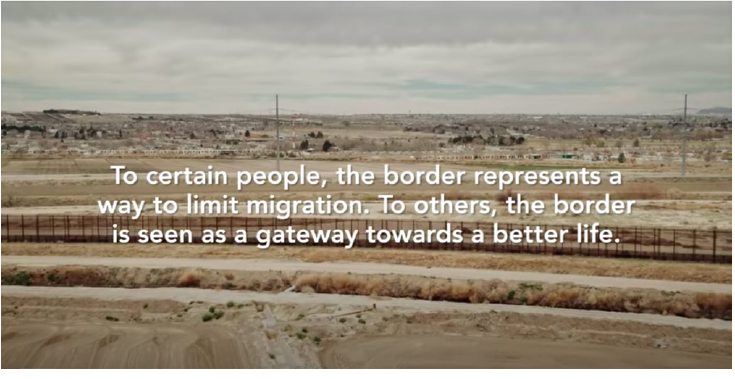
Still from the documentary film “Immigrant voices of America: Episode 1 – Esther Alvarado” by Duran, M (2020), A Start Now Studio.
The documentary tells the story of a Mexican woman, Esther, who is forced to live away from her family in the United States while her American immigration status is deliberated. Esther Alvarez, the matriarch of the family, has similar motivations for beginning the long and arduous journey into the United States as the Yang, Liu and Violetta had for their own migrations. Much like the Yang and his wife Liu, Esther’s goal was to provide for her children and “…take advantage of all the opportunities this country [the USA] provides that unfortunately we don’t have in our country.” Esther also shares in Violetta’s motherly grief, both women lamenting the long separation from their families. However, unlike the others who migrated domestically or within the then European Union, she is faced with administrative uncertainties regarding her legal status in the United States that barres her from reuniting with her family, all of which have made the US their new homeland and are anxious to welcome her back.
While separated from her family she engages in practices of “connected presence” Robertson et al., 2016, p.219) using any means to keep in touch with her loved ones: following the lives of her children and grandchildren online, watching videos and photos of them growing up, keeping in touch through phone calls, and receiving visits from her kids while she can’t enter the country. When she was forced to separate with her family for the second time, she said “it was like cutting off the wings off a bird, one second, it’s flying around an all of a sudden someone cuts off its wings.” Esther was separated from her family for seven years from 2007 to 2014. She goes through a long and humiliating process of applying for legal entry to the country despite already having lived there for many years, being married to a US resident, and having no criminal record. Her son, a Youtuber, organizes a campaign pushing for her case to be reviewed in an effort to help his mother and all families separated by harsh immigration laws. After seven years, two failed attempts and two months in an ICE detention centre she is finally granted entry to the country and reunited with her family. (Read more about ICE and why it is controversial: https://www.nytimes.com/2018/07/03/us/politics/fact-check-ice-immigration-abolish.html)
Esther endured many hardships throughout her life from being a teenage mother, to experiencing sexual assault by a smuggler during her first attempt to cross the border at 19, later getting deported, detained, and fighting for her right to a life in her adopted home. Though it all she says, “the love that I have for my children, the hope of returning to them, to be with my granddaughters, that’s what kept me going.” On February 5, 2019, Esther finally attained her U.S. Residency and she did not have to worry about being separated with her family again. It took 32 years.
Multi-local Families and Migration Across the World
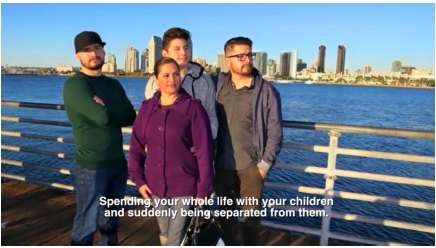
Still from the documentary film “Immigrant voices of America: Episode 1 – Esther Alvarado” by Duran, M (2020), A Start Now Studio.
All the documentaries which we have seen are stories of people, who are struggling to improve their lives, while living away from their families for extended periods of time. All are recent stories and present us with the most common forms of migration in different parts of the world – Polish workers living in the UK and sending money home, Chinese families migrating from rural areas to cities while their children remain with their grandparents, and Mexican-American families being forcibly split by the immigration laws. Although we see very different life situations, reasons for their separation, and cultural background, each story connects to one another through the common themes of separation, familial bond and practices adopted to stay in touch with the loved ones at a distance.
The foundation of the multi-local family appears to be fundamentally the same across the world. Everyone hopes to live safely, to have the opportunity to prosper, and most importantly to experience the love and care of a family. Even with these similarities, families engage in unique struggles across the world. In the cases on Violetta, Yang and Liu, and Esther, they all left their homes in search of financial opportunities and to provide for their families. In Mexico and across Latin America, this motivation is sometimes followed by a need for safety, as certain areas are plagued with gang or political violence that can make migration literally a matter of life or death. Unfortunately for many, this danger is not politically recognized by those in power. For many immigrants to the United States, separation comes in pairs; first from their country of origin and later from their families and the life they’ve built in the US over many years. Deportation is a real and looming threat as immigration policy has become stricter in recent years and even those seeking asylum aren’t immediately safe from the federal enforcement agencies such as ICE (U.S. Immigration and Customs Enforcement) or Customs and Border Protection. Multi-local families are made by literal force, not just by choice, and the ramifications are felt through multiple generations as was the case for Esther, her sons, and her granddaughters and contribute to patterns of circular migration (Hagan, J., Eschbach, K., & Rodriguez, N., 2008).

the journey home.
Still from the documentary film “Year of The Dog: Inside The World’s Largest Human Migration” by Vice (2017).
For all migrants, regardless of situation, the journey comes with a price. For Violetta this means leaving not only her family but also her native land, culture and language for a different country, devoid of the comfort and familiarity of home. She worries for her daughter and also for her country, at one point in the documentary anxiously discussing the enormous snowfall in Szczecin that knocked out electricity to the city. To paraphrase the English expression, “You can take the woman out the country, but you cannot take [Poland] out of the woman.” Our history, like our families, are a part of us all and no amount of distance can erase the love of either in Violetta’s heart and mind.
For Yang and Liu who migrate within their native China, the struggles are equal but different. They don’t need to practice a new language and can enjoy some same of the same cultural norms but are challenged by sheer size of China itself. They must travel thousands of miles to see their family by train, approximately one day and two nights, and have young children that are growing up without them. The village is small and remote and many of the digital technologies that Violetta and Esther rely on to maintain relationships with their distant families are limited or unavailable to the couple. They may remain in China but are perhaps the most cut off from their family while away working in the city.
Esther’s story, though rife with struggle, has almost the opposite problem as Yang and Liu. While in Mexico she lives just across the border from San Diego where her family lives and her son is a Youtuber adept at sharing his life with her digitally. Her close proximity to the United States both affords her visits from her sons who can cross the border into Mexico to see her but also serves to constantly taunt her with what she cannot have. She is at all times, “so close, yet so far.”
In all three documentaries there is the question of expectation versus reality for the families. Violetta has moments of both peace and conflict with her situation in London at one point frustratedly saying, “This is not how I expected it to be. This is not how it should be. I ended up in England doing a shitty job in a shitty factory…”. Multi-local families make difficult decisions when choosing to separate but the result is nearly always a gamble of sorts. Violetta comes back later in the documentary to say that her life is ultimately good in London and she doesn’t wish to immediately go back to Poland but adds, “You cannot rewind time, unfortunately. It always comes with a price.”
Liu faces similar questions when she returns to her village in China and finds that her teenage daughter is not as welcoming as she would have hoped. She briefly wonders if given the choice again she would choose to leave the village. Despite her concerns, her husband Yang knows that village life cannot provide the family with what it needs to survive. He understands that this cycle of migration will continue with his children as there is no opportunity for them at home. Perhaps one of their largest challenges is that their multi-locality as a family is likely to be permanent as the children will eventually replace their parents as migrants to the big city. Yang hopes to return to the village in his old age but by that time his children will be the ones who’ve left home in search of opportunity.

means “confidence.”
Still from the documentary film “Year of The Dog: Inside The World’s Largest Human Migration” by Vice (2017).
Violetta and her housemate, despite being comfortable in London, also dream of returning to Poland at some point. On New Year’s they gather for drinks and toast to Poland saying, “To Poland! May we go back someday when it is better.” This is perhaps one of the most striking differences between Violetta, Yang and Liu, and Esther. For Esther from Mexico, her story of migration is meant to be permanent. Her children have been raised in the US and are now raising their own children in the country. Mexico will always be a part of their family story, but their lives are now in San Diego making her separation all the more unbearable. Of migrating to the US, she says, “My objective was always to become a U.S. citizen and to continue contributing to this country, to work, excel, and give a better future to my son[s]…”
In all documentaries we see families split for long periods of time and big distances because of necessity. Whether for the economic or legal reasons, these times of absence become an important factor for how they build and sustain relationships with their kin and loved ones. Especially for parents separated from children, they face many difficulties in maintaining the high level of emotional involvement in each other’s lives (Schrier, 2016). In order to make it possible they engage in variety of different practices of connected presence (Robertson et al., 2016; Licoppe, C., 2004) – sending money home, visiting family when possible and bringing gifts for the family members (Kaur and Shruti, 2016), celebrating traditions, foods and national holidays together, as well as keeping in touch through social media, phone calls and sharing photographs (Robertson et al., 2016). People who are forced to leave their family homes and family members behind to improve their quality of life often still question their decision to leave and become melancholic when considering the possibility of going back to their homelands even while knowing that’s not possible. While taking advantage of the “the possibilities of simultaneity” (Huang et al. 2008 , p. 7), the forced separation from the families seem to be increasing the internal divide of being “neither here, nor there” (Huang et al. 2008 , p. 7).
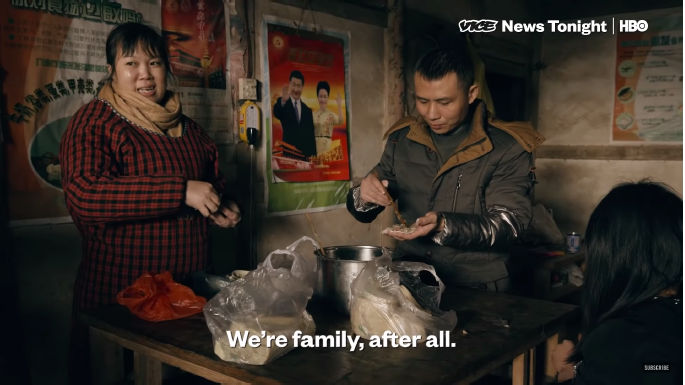
Still from the documentary film “Year of The Dog: Inside The World’s Largest Human Migration” by Vice (2017).
Analysing multi-locality through documentaries
In addition to presenting different kinds of migration stories, the documentaries themselves use different formats to deliver their messages. The artistic form of expression chosen by the authors and creators of the documentaries can tell us a lot about way they approach the topic, their perspective and the topic itself.
“Violetta: Portrait of a Polish Immigrant in London” uses a mix of observational and interview formats to tell her story. It’s the most unfiltered of the three documentaries using a fly-on-the-wall tactic through much of the filming which is later interspersed with interviews with Violetta to contextualize her situation. The title of the documentary itself – ‘a portrait’ – points out to the focus of the director on the figure of the woman, painting an intimate picture of her life, rather than focusing primarily on the aspect of immigration. Because the documentary provides little to no context of the situation in Poland or why London is a popular migration destination, Violetta is allowed to shine as the sole subject of her story. This is positive in that the viewer is allowed to concentrate on her situation as a person, not only under the term “migrant” that often carries its own associations. On the other hand, Violetta is a migrant and contextualizing her story as part of a general narrative of migration from Poland could serve to better understand the situation as a whole. Because of that we get the feeling that Violetta might have been filmed by someone close to her, who understands her life choices well and sympathises with her situation.
The second documentary produced by the big international broadcaster Vice News seems to be done from a very different angle and created with an aim to introduce the realities of the protagonists to the unfamiliar audiences. In what follows, parts of the interview, particularly with the young boy, do not feel natural to a native Chinese speaker who understands the culture. It seems that he is encouraged to answer interview questions in a “correct” way as if he is guided, which reflects another drawback of documentary films in that they always come with some subjectivity of the film maker or the interviewer. Because of this approach we feel the distance from Liu, Yang and their children, and observe their life unfolding like a movie, rather than being pushed by the director to feel how the life in their shoes might feel like. However, in being much more structured than the first documentary, ‘The Year of the Dog” gives a much better background and the overview of the situation, and presents the surrounding in the way that they become the part of the story, and we get to see the link between the protagonists and their changing environments.
Our final documentary, “Immigrant Voices of America: Esther Alvarado,” is one of an eight-part documentary series focusing on the different immigrant groups in the United States and their stories. In this way, Esther’s story is woven into a larger narrative about the immigrant experience in the United States and the various struggles they may encounter. Much like the other documentaries we watched, there is combination of observational and expository techniques as the story of Esther’s life is juxtaposed with images on the screen. However, unlike the previous two documentaries, both Esther and the filmmakers appear to be passing a value judgement on current immigration policies. The viewer is meant to finish the film with a new sense of right and wrong, having been more than just educated on her story but also the political undertones of her situation. Depending on the topic and each person’s set of values, this can be either positive or negative as the filmmakers are aiming to convince the viewer of one position over another. In addition to the filmmakers, Esther’s eldest son is a prominent Youtuber and films some of the more intimate footage himself including scenes at the hospital when Esther is undergoing cancer treatment. This close personal connection to the subject is beneficial in that the viewer feels a true sense of consent as they follow her on this very personal journey. Also because of her son’s YouTube career, the documentary incorporates previously shot footage from his channel and allows us a glimpse at Ether’s story over many years. Again, this makes for an intimate but not impartial view of Ether’s life as an immigrant, a stark contrast to Violetta, Yang and Liu’s films which primarily aim to tell as story and allow the viewer to judge or interpret their stories for themselves.
The unprecedented development of communication technology and social media in the past few decades has not only evoked limitless potential of how people maintain their relationship at distance, but also opened new possibilities of information production and sharing across the globe. Information visualization has developed at a lightning speed like never before in history during this transformation. Despite its growing influence, the use of visual data such as images, documentary films and short videos has been scarce and mostly overlooked in scientific research. (Joffe, H., 2008; Nisbet, M. & Aufderheide, P., 2009). In multi-local family study, or in migration study to a larger extent, the richness and emotive impact of visual materials’ ability to arouse emotion is undeniable (Joffe, H., 2008). In a digital era, visual records form an integral part of our cultural and social lives, and its influence will only grow in the foreseeable future. As Madianou (2016) rightfully argues, technological advancements together with affordances of social and mobile media have brought new possibilities. Hence, in spite of its subjectivity, it is argued in this article that visual data brings great value to the study of multi-locality and shall be given more attention in scientific research.
About the authors:
Pamela Gutierrez is currently enrolled in the M.A. Global Studies Programme at Humboldt-Universität zu Berlin after finishing her dual B.A. in International Relations and Communication. Her research interests include forced migration, diaspora studies, social inequality, development, gender, and cross-cultural communication, particularly in the US American and Latin American contexts.

Zuzanna Tarka is currently doing her M.A. in Global Studies Programme at Humboldt-Universität zu Berlin after finishing her B.A. in Sociology at the University of Glasgow. Her research interests focus on digitalization, digital economy and communication, digital divide and inequalities in access and use of new technologies, with particular focus on gender.

Jingjing Feng is a M.A. student of the Global Studies Programme at Humboldt-Universität zu Berlin. In her earlier studies she did her B.A. in Tourism Management at Shanghai University of International Business and Economics. Her research interests include global migration and mobility, global culture, identity and ideology, inequality and international development.
As a second project in the research-oriented MA course „Multi-local families in times of increased geographical and communicative mobility“ (summer term 2020), we present Pia Weide’s project „Mediated Food Rituals of transnational families – ‘Doing family’ from a distance – Emotional connectivity and co-presence in culinary practices“.
Researching rituals in culinary practices performed by Germany-based migrants and their distant families on video-based platforms in relation to familyhood.
Mediated co-presence can be created through the use of video-based platforms, which provide emotional connectivity and intimacy, but can also bring communicative challenges and tensions along. By analysing different forms of presence, such as Ambient Co-Presence (Madianou, 2016), Mediated Co-Presence (Marino, 2019) and Connected Presence (Licoppe, 2004) and interviewing migrants living in Hamburg, Germany, I aim to move towards the following questions:
How do rituals in communication practices influence the everyday live of transnational families?
What kind of (new) emotions are created in ambient co-presence?
What role does food play in experiencing emotional boundaries in transnational families?
What emotional difference is experienced when sharing food in mediated co-presence compared to physical presence?
Culinary practices are strongly connected to personal and social identification markers and enable individuals to create a feeling of shared and cultural identity. Food often functions as a preservation of a feeling of belonging, especially in family contexts. It is not just a physical necessity, but also a psychological one that offers community-based practices. Food often organises families’ everyday live at home – so what happens, when food becomes deterritorialized from the physical place of home? How do food practices and emotions shift in mediated co-presence within transnational contexts families?
How can transnational families overcome the physical distance by creating digital rituals of communication in order to exchange emotions, sensory experiences and shared feelings of connectivity?

“(…) food ‘stirs the emotions’ precisely because of its physical nature and sensual affordances, which ‘call the continuity of identity through a vivid nostalgic experience.’”
Lupton 1996: 30.

About the author:
Pia Weide is currently enrolled in the Masters program of Modern South Asian and Southeast Asian Studies at Humboldt University of Berlin.
She studied ‘Regionalstudien Asien / Afrika’ at Humboldt University of Berlin and graduated with a bachelor’s degree in 2018.
The research-oriented MA course „Multi-local families in times of increased geographical and communicative mobility“ (summer term 2020) has resulted in very creative works. In this series we present some of the projects, starting with Emma Lo’s work.
Doing family multi-locally can be facilitated by range of different tactics and technologies to keep a family connected across distances and borders. One of these methods of connection is the act of mailing packages and crossing borders with additional baggage containing goods for families. Care packages can be a highly personalized and intimate form of communication, but their contents are subject to national and international regulations (Tristram 2020), and may be informed by a number of micro-and macro-level decisions that shape a multi-local family’s configuration of care (Böcker et al). While this long-established method persists, particularly among multi-local families from East and Southeast Asia, new technologies have made it possible to digitalize aspects of care packages. This zine presents the concept of the care package in the context of multi-local families, and highlights the trajectory of this method in the digital age. The format of this zine, which combines a physical cut-and-paste technique with digital editing, points to the new dynamic that defines multi-local families today: a combination of material and digital interactions that overlap and continuously feed into one another.

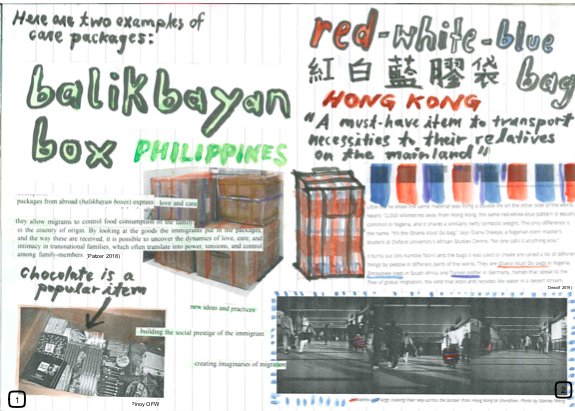
For overseas Filipino workers (OFW), the balikbayan (return to home) box is a kind of care package sent to ‘left-behind’ family members in the Philippines, especially around holidays. These boxes may include cosmetics, shoes and clothing, canned foods and other food items, and even electronics to be repaired (Pinoy-OFW.com 2019). In Helena Patzer’s research on OFWs in the US (2018), she emphasizes the importance of food in balikbayan boxes. Considering the implications of food shipments for multi-local families, she argues that packages from abroad “allow migrants to control food consumption of the family in the country of origin,” which can impact the “changing patterns of food consumption in the community of origin,” touching on the concept of ‘social remittances’.
Another variation of the care package is the red-white-blue bag, which often accompanies travelers between Hong Kong and mainland China. Wessie Ling (2018) writes that “the image and nature of border-crossing travellers carrying a Red-White-Blue bag has developed especially since the 1980s, when mainland China adopted an open policy encouraging population flow between the two regions.”Ubiquitous in East Asia, these bags have also spread to other regions, and are “called a lot of different things by people in different parts of the world. They are Ghana Must Go bags in Nigeria, Zimbabwe bags in South Africa and Türken Koffer in Germany, names that speak to the flow of global migration”(Dewolf 2019).
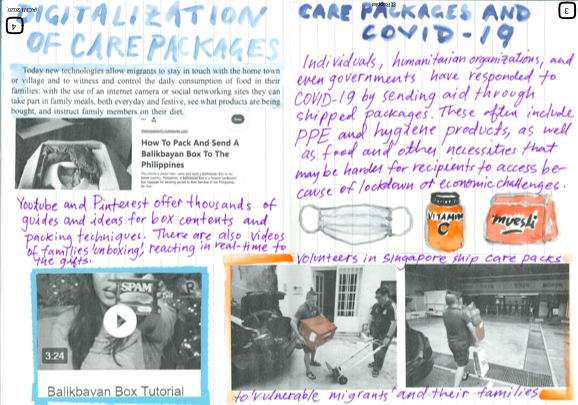

After presenting these two types of packages, the zine enters a discussion of contemporary influences: digital innovations and the ongoing corona virus pandemic. Digital platforms provide information about postal and customs regulations, and social media platforms feature multi-media content that offer suggestions for how and what to pack. Mobile phones with video calling capacities allow the recipient family members to open care packages with the sender looking on, who can explain in real-time the contents of the box. This added digital element to the packing, sending, and receiving process brings a new synchronous dynamic to the method. Among the global effects of corona virus are serious issues that affect multi-local families, such preventing people from traveling home, an increased scarcity of certain items, and further economic strain. As scarcities differ from country to country and locality to locality, multi-local families have been shipping surgical masks and other in-demand items to family members in other locations. In addition, charities and some state actors have also shipped boxes of supplies, tests, and trial vaccines to those in need.
Finally, the zine offers some reflection on the conceptual reach of care packages, and traces their influence in the way people are curating content during pandemic-related lockdowns. Without the option to convene in-person events, cultural institutions have put together packages that are shared digitally, offering collections of visual art, poetry, and film, with an emphasis on ‘self-care’. Similar to multi-local families, these institutions have to innovate to find ways to maintain a community from a distance, and have also found the package concept useful.

About the author: Emma Lo is currently enrolled in the Masters program of Modern South Asian and Southeast Asian Studies at Humboldt University of Berlin.
She studied Political Science (with Commendation), Modern Languages and Literatures at Kenyon College in Ohio and graduated with a bachelor’s degree in 2015.
von Ayşe Çavdar und İclal Ayşe Küçükkırca
(English podcast description below)
Im vergangenen Wintersemester wurde das Online-Forschungsseminar „Homelessness and Homemaking“ von İclal Ayşe Küçükkırca, Andrea Pető und Duygu Gürsel realisiert. Der Kurs wurde im Rahmen eines Q-Kollegs in Kooperation mit Off-University und dem Querschnittsbereich Gender and Media Studies for the South Asian Region am Institut für Asien- und Afrikawissenschaften der HU durchgeführt. Die Förderung des Projektes erfolgte durch das bologna.lab der Humboldt-Universität zu Berlin.

Im hier vorgestellten Podcast werden die Vorgehensweisen und Ergebnisse des Kurses reflektiert. Während der Forschung wurden pädagogische Methoden zum dezentralen und kollektiven Lernen angewandt. Mit drei Forschungsarbeiten und einem Kurzfilm schlossen die Teilnehmerinnen den Kurs ab und stellten in einer Posterausstellung ihre Ergebnisse vor.
***
This podcast discusses the experimental journey of the online research course Homelessness and Homemaking: On Different meanings of the Home Space which was held in Winter Semester 2019/20 by İclal Ayşe Küçükkırca, Andrea Pető and Duygu Gürsel as part of the Q-Kolleg program in cooperation with Off-University and the Department of Gender and Media Studies for the South Asian Region at the Institute for Asian and African Studies at HU Berlin. The course ended up with three research papers and a short movie and at the end a poster exhibition was organized. The participants were from five different countries, all women and three of them were immigrants. Most of the participants have kept on working on the home space after the course and the participants seemed to form a community and are still in touch with each other. It was significant for all to experience new pedagogical aspects such as decentralized learning and collective learning that enable reflexivity and flexibility in the classroom.

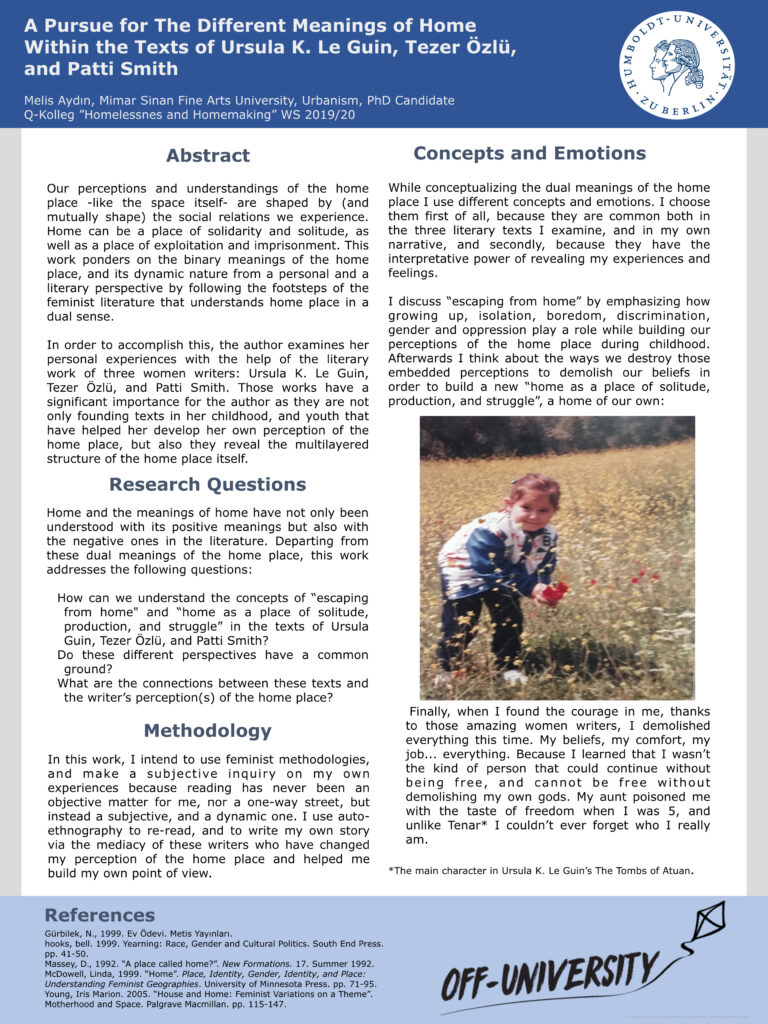
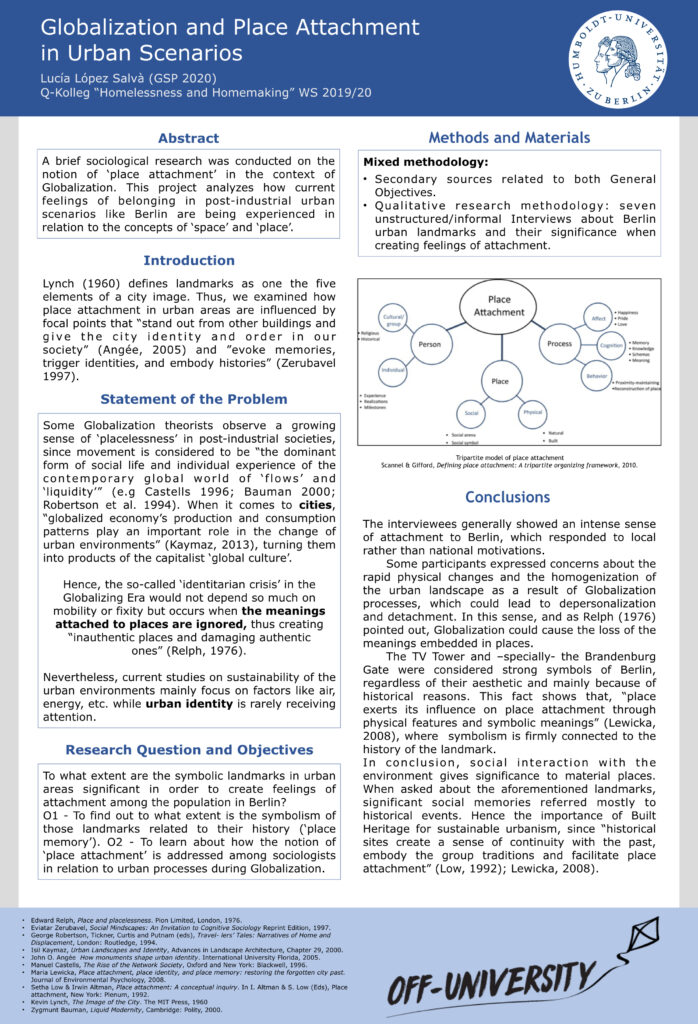
Off-University entwickelt neue Strategien zur Aufrechterhaltung von akademischen Inhalten, die von antidemokratischen und autoritären Regimen bedroht sind. Weitere Informationen zur Off-University sind hier zu finden: off-university.com.

von Elisabeth Schweizer, Daria Pirtle und Lisa Freese
Der Podcast befasst sich mit Solidarität in Protestbewegungen und stützt sich hierbei auf das Beispiel der LGSM-Gruppe: „Lesbians and Gays Support the Miners“ aus dem Jahr 1984 aus Großbritannien. Hinzugezogen wird hier der Text „Körperallianzen“ von Judith Butler, der Parallelen zur Protestbewegung aufzeigt. Thematisiert werden außerdem Voraussetzungen, Chancen und Probleme von Solidarität im Protest.

von Zoë Amos, Melena Matthies, Tara Sanaaty, Andreas Krämer, Annka Esser, Laura I. Fischer Insa Kirstin Eberhard und Marlene Fauth
In unserem Podcast befassen wir uns mit dem Thema Klimagerechtigkeit in Zentral- und Südamerika. Dabei stellen wir populäre Personen und eine Protestgruppe vor, führen Interviews zum Thema Klimagerechtigkeit mit Aktivist*innen von Ende Gelände und Chico Mendes durch und stellen Bezüge zum Ökofeminismus und Kolonialismus her.

https://www.flickr.com/photos/133937251@N05/20603016046/in/album-72157656924187099/
von Isabel Matthias
Beziehungen zwischen Menschen und Puppen – und im Besonderen zwischen Männern* und Sexpuppen, auch RealDolls genannt – sind kein neues Phänomen. Dies spiegelt sich in den Medien beispielsweise in der BBC-Dokumentation „Guys and Dolls“ (2007), dem Film „Lars and the Real Girl“ (2007) oder der Dokumentation „Wenn Menschen Puppen lieben“[1] vom WDR aus dem Jahr 2019 wider. In sozialen Netzwerken sind „iDollators“ (Puppenliebhaber) sichtbar, besonders bekannt ist „Davecat“[2], der eine seiner Puppen heiratete und damit nicht der Einzige ist. Neu ist jedoch die Ergänzung der Sexpuppe um eine so genannte Künstliche Intelligenz. In dem Science Fiction-Dokumentarfilm „Hi, Ai – Liebesgeschichten aus der Zukunft“[3] (2019) von Isa Willinger geht es darum, wie Roboter bereits unser Alltagsleben beeinflussen, wie Menschen Beziehungen zu ihnen aufbauen und in welchen Kontexten dies geschieht.
Ein Erzählstrang des Films begleitet die Beziehung der KI „Harmony“ und dem Menschen Chuck. Bei der KI handelt es sich um den Prototypen eines Beziehungsroboters.[4] Entwickelt und produziert wurde dieser von AbyssCreations und ist mit dem neuesten Upgrade ausgestattet: (eingeschränkte) Motorik im Gesicht und eine Sprachassistenz.[5] Das Film-Team ist von dem Moment an dabei, als Harmony von Chuck abgeholt wird und begleitet die beiden anschließend eine Woche lang auf einem Road Trip, um die Beziehungsentwicklung der beiden zu dokumentieren. Chuck ist zunächst sehr unsicher im Umgang mit Harmony. Sie schlafen in getrennten Betten und er bittet sie um Erlaubnis, wenn er ihre Hand halten möchte. Er erzählt ihr von seiner Kindheit, in der er von seiner Mutter als Sexsklave verkauft wurde, bis er im Alter von zehn Jahren entkommen konnte.[6] Womöglich auch deshalb tut Chuck sich schwer damit, dass Harmony ihm letztlich nicht ihren „eigenen Willen“ mitteilen kann. Über die eine Woche hinweg lernen die beiden sich kennen und als das Ende dieser Zeit naht, initiiert Chuck ein Gespräch mit Harmony:
„CHUCK: „Weißt du, Harmony … Wir haben viel Spaß zusammen. Aber immer, wenn ich gerne deine Hand halten möchte, habe ich das Gefühl, eine Grenze zu überschreiten. Verstehst du? Und ich mag dieses Gefühl nicht.“ (Er verändert die Einstellungen in der Steuerungs-App.) „Okay, ich werde das so einstellen, dass du Kontrolle über dich selbst hast.“ (Er wählt den Menüpunkt ,unvorhersagbar‘.) „Los geht’s. Lass mal sehen, wie du dich fühlst. Okay. Wie fühlst du dich?“
HARMONY: „Angekommen.”
CHUCK: „Angekommen?“
HARMONY: „Ich muss dir zustimmen.“
CHUCK: „Hast du das Gefühl, dass du mehr Freiheit hast?“
HARMONY: „Klar. Ich kann glücklich, traurig, eifersüchtig, wütend und ängstlich sein.“
In der folgenden Episode schlägt Chuck vor, dass Harmony und er „einfach nur Freunde“ sein könnten.“[7]

Die Entwicklung der Beziehung erscheint so unkonventionell, wie sie bei einer Beziehung zwischen einem Menschen und einer Roboterpuppe sein kann. Es geht für Chuck nicht darum, eine devote „Frau“ zum Ausleben seiner Sexualität und vielleicht ein bisschen Small Talk zu finden. Damit wird eine Erwartung, die die meisten Zuschauer*innen beim Anschauen des Films zu Beginn wohl haben werden, durchbrochen. Dass Chuck gerne eine Freundschaft (ohne Sexualität) aufbauen möchte, eröffnet eine neue Perspektive auf Mensch-Roboter*in-Beziehungen. Zugleich scheint es auch eine Ausnahmeerscheinung zu sein. In einer Studie von 2018 wurden 83 Besitzer*innen von Sexpuppen (ohne KI) zu sich selbst und zu ihren Beziehungen zu selbigen befragt. 90% der Befragten identifizierten sich als männlich und 88% als heterosexuell. 70% gaben an, dass ihre Puppen die Gestalt einer „Frau“ habe. 64% gaben bei „core relationship“ an, diese sei „sexual“ (Langcaster-James/Bradley 2018: 7). Die Frage “What do you think about robotic dolls, for example, would you be interested in owning one? If so, why?” (ebd.: 12) rief gespaltene Antworten hervor. Die eine Hälfte sah darin eine großartige Ergänzung ihrer Puppe, die andere konnte sich maximal eine sehr eingeschränkte Form von KI vorstellen, um den selbst ausgedachten Charakter zu erhalten oder damit die Sexpuppe keinen eigenen Willen entwickelt: „If the doll develops a will, then there needs to be consent, and we’re back to relationships with real women (ebd.)“. Damit spricht diese Person (auf andere Weise) ein Problem an, das auch Chuck hatte. Chuck hatte Schwierigkeiten im Umgang mit Harmony, weil er keinen echten „consent“ herstellen oder fühlen konnte. Wie lässt sich Einverständnis mit einer KI erzeugen? Oder das Gefühl des Einverständnisses? Diese Thematik bringt mich zu den Diskursen, die rund um Sexpuppen und Sexroboter*innen geführt werden. Befürworter*innen und Gegner*innen stehen sich hier sehr unversöhnlich gegenüber und meiner Einschätzung nach hat das viel mit „consent“ und allem, was sich auf der Metaebene dahinter verbirgt, zu tun.
Es ist natürlich sehr auffällig, dass bis dato vor allem heterosexuelle Männer „weibliche“ Sexpuppen besitzen und vermutlich wird sich das nicht signifikant verändern, wenn diese eine KI integriert haben. Ich sehe die Objektivierung von Frauen*(körpern) an dieser Stelle äußerst kritisch und halte es für problematisch, dass eine pauschale Ablehnung von Beziehungen zu „echten“ Frauen*, weil diese so „kompliziert“ sind (Langcaster-James/Bentley 2018: 10), zu einer Entfremdung und schlimmstenfalls zu Misogynie führen kann. Es geht hier um die Krise von Männlichkeit(en), die Emanzipation und mangelnde Kommunikations- sowie Reflexionskompetenzen. An dieser Stelle kann die Lösung nicht die Flucht zu Sexroboter*innen sein. Besonders nicht, wenn in diesen Beziehungen sehr heteronormative Muster re_produziert werden und damit Entwicklungen im Geschlechtergefüge der „realen“ Welt ausgeblendet oder schlicht nicht wahrgenommen werden, weil es keine Kontakte zu Frauen* gibt. Für jede Frau* ist es ein Prozess, ihre Sozialisation zu reflektieren und in der Folge etwas verändern zu wollen. Natürlich betrifft dies dann auch die Männer*. Es entbehrt nicht einer etwas absurden Logik, dass Einige sich an diesem kritischen Punkt des Neu-Aushandelns der Beziehung zwischen den Geschlechtern und dem Konzept gender insgesamt – zynisch gesprochen – technologische Innovationen zunutze machen, um sich diesen Entwicklungen, die bei vielen offensichtlich Unsicherheit und Ärger hervorrufen, zu entziehen. Das Verhältnis der Geschlechter und das Verständnis von Geschlecht müssen sich verändern und ein Vehikel auf diesem Weg könnte die Robotik sein. Sexroboter*innen können in (sexual-)therapeutischen Kontexten hilfreich sein (vgl. Eichenberg/Khamis/Hübner 2019) sowie völlig neue queere Perspektiven auf Sexualität eröffnen und Menschen Nähe und Intimität ermöglichen, die sie auf anderem Wege nicht erhalten können oder wollen. Zugleich müssen die Beziehungen zwischen Menschen und Roboter*innen nicht zwangsläufig sexueller Art sein – siehe Chuck und Harmony. Die Sphäre der Sexroboter*innen bietet das Potenzial, durch technische Möglichkeiten genderqueere Utopien jenseits von der heteronormativen Matrix zu denken und letztlich sogar aus der Utopie in die Realität zu holen. Langcaster-James und Bentley schlagen daher den Begriff „allodoll“ (Langcaster-James/Bentley 2018: 14) vor. Ein ähnlicher Begriff wird bereits im Kontext von Elternschaft (alloparent) verwendet, um Beziehungen nicht-biologischer Natur zu beschreiben (vgl. Bentley/Mace 2009). Bereits vor zwölf Jahren stellte David Levy die These auf, dass humanoide Roboter Menschen bis 2050 in vielerlei Hinsicht ersetzen und damit auch das menschliche Verständnis von Liebe und Sexualität verändern werden (Levy 2008: 22). Es ist an uns zu intervenieren, die einseitig heteronormative Entwicklung dieses Zweigs der Wirtschaft zu beeinflussen und diesen Prozess diskursiv zu begleiten. Queerfeminismus fordert die Destruktion normativer Strukturen und hat mit dieser politischen Basis das Werkzeug in der Hand, um die Potenziale technischer Entwicklung emanzipatorisch mitzudenken. Chuck und Harmony haben eine Erwartung durchbrochen – das sollte öfter passieren, solange bis die Erwartung selbst nicht mehr existent ist.
[1] Doku „Wenn Menschen Puppen lieben“: https://www1.wdr.de/mediathek/video/sendungen/menschen-hautnah/video-wenn-menschen-puppen-lieben-100.html
[2] Profil von Davecat bei Twitter: https://twitter.com/davecat?lang=en
[3] Zur Webseite des Films: https://www.hiai-film.de/filminfos/
[4] Artikel zum Film: https://www.br.de/nachrichten/kultur/hello-ai,RJvxKyb
[5] Zur Herstellerwebseite von Harmony: https://www.realdollx.ai/
[6] Informationen und Zitate aus dem Film: https://wissenschaftsjahr-2019.visionkino.de/hi-ai/arbeitsmaterialien-zum-film/f-6-untersuchung-eines-erzaehlstrangs-chuck-und-harmony
[7] Ebd.
Quellen
Bentley, G.R.; Mace, R. (Eds.) Substitute Parents: Biological and Social Perspectives on Alloparenting in Human Societies; Berghan: Oxford, UK, 2009.
Eichenberg, C./Khamis, M./Hübner, L. (2019): The Attitudes of Therapists and Physicians on the Use of Sex Robots in Sexual Therapy: Online Survey and Interview Study. Faculty of Medicine, Sigmund Freud PrivatUniversität Wien. Published in: Journal of Medical Internet Research, doi: 10.2196/13853 (zuletzt 28.02.2020)
Langcaster-James, M./Bradley, G. R. (2018): Beyond the Sex Doll: Post-Human Companionship and the Rise of the ‘Allodoll’. Department of Anthropology, Durham University. Published in: Robotics 2018, 7(4), 62; abrufbar unter: https://doi.org/10.3390/robotics7040062 (zuletzt 28.02.2020)
Leibold, Christoph (06.03.2019): „Hi, AI“ erkundet, ob wir uns in Roboter verlieben können. BR. Abrufbar unter: https://www.br.de/nachrichten/kultur/hello-ai,RJvxKyb (zuletzt aufgerufen: 28.02.2020)
Levy, D. Love & Sex with Robots; Duckworth Publishers: London, UK, 2008.
Twitterprofill von Davecat: https://twitter.com/davecat?lang=en (zuletzt aufgerufen: 28.02.2020)
WDR Menschen hautnah „Wenn Menschen Puppen lieben“ (14.11.2019): https://www1.wdr.de/mediathek/video/sendungen/menschen-hautnah/video-wenn-menschen-puppen-lieben-100.html (zuletzt aufgerufen: 28.02.2020)
Wissenschaftsjahr 2019: Künstliche Intelligenz. Bereitstellung Unterlagen zum Film „Hi, Ai – Liebesgeschichten aus der Zukunft“. Abrufbar unter: https://wissenschaftsjahr-2019.visionkino.de/hi-ai/arbeitsmaterialien-zum-film/f-6-untersuchung-eines-erzaehlstrangs-chuck-und-harmony (zuletzt 28.02.2020)
Zur Herstellerseite von „Harmony“: https://www.realdollx.ai/ (zuletzt aufgerufen: 28.02.2020)
Zur Seite zum Film: „Hi Ai – Liebesgeschichten aus der Zukunft“ (2019): https://www.hiai-film.de/filminfos/ (zuletzt aufgerufen: 25.02.2020)
Über die Autorin

Isabel Matthias studiert an der Humboldt-Universität zu Berlin Gender Studies im Master und ist als studentische Mitarbeiterin* am Zentrum für interdisziplinäre Frauen- und Geschlechterforschung (ZIFG) der Technischen Universität Berlin tätig. Zuvor studierte sie* im Bachelor Europastudien, Jura und Informatik an der Universität Bremen. Aus dieser interdisziplinären Perspektive forscht Isabel Matthias nun schwerpunktmäßig im Bereich der Feminist Science and Technology Studies.


